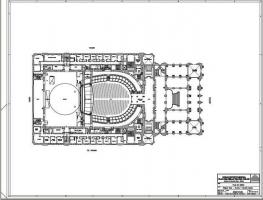Pyramids of Egypt: history, characteristics, function and meaning
The pyramids of Egypt are the oldest constructions that remain standing. Conceived for eternity, they are the living testimony of a religious mindset, but also of a powerful and prosperous empire, whose vocation to power allowed it to sustain itself for more than 3000 years.

The pyramids of Egypt are an enigma for society, although they were not always in the eye of the world. Stripped of some of their beauty throughout history, the pyramids were covered by the veil of silence for a long time, at least for the Western world.
Several milestones in history would influence this. The first of them, the fall of the Egyptian empire before the Roman empire in the year 31 a. C., when Octavio triumphed before Marco Antonio, lover and ally of Cleopatra, in the battle of Accio. After that, some pyramids were used as a quarry for Roman engineering projects.
The same fate would befall the pyramids when the Muslims, centuries later, used the limestone from the facades for their mosques and buildings.

It was in Napoleon's campaign for those lands that interest in the Egyptian world revived. Napoleon brought a group of intellectuals with him to record the findings. The campaign of Egypt and Syria, which took place between 1798 and 1801, had as its only trophy the treasures of those magnificent pyramids. This was the birth of the Egyptology, the science that studies the history of Ancient Egypt.
The birth of the pyramids
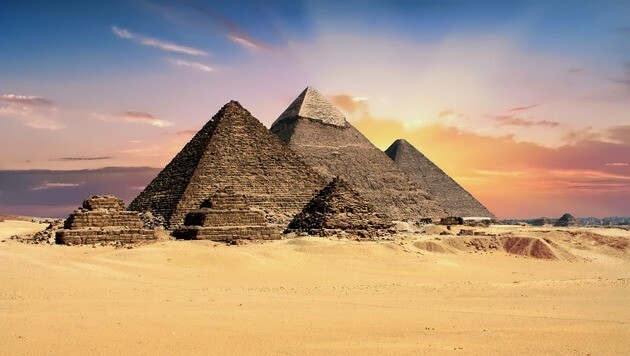
The archaic period of Egypt will be the starting point for the formation of this vast empire. It was born with the unification of Upper Egypt (north) and Lower Egypt (south) in the mandate of Menes or Narmer, founder of the 1st dynasty. This process would have started around the year 3150 BC. C.
The site will be the fertile land of the Nile River, whose annual floods facilitated cultivation. Added this to the construction of canals and dikes, the river favored less laborious agriculture and, therefore, free time for the development of other companies. Likewise, the Nile was an important and prosperous trade route.
It will be the pharaoh Zoser who inaugurates the Old Kingdom when founding the III dynasty, around the year 2700 a. C. approximately. This pharaoh will start a true cultural revolution with the construction of the stepped pyramid of Saqqara, the first pyramid.
Only after it, the architects at the service of the Fourth Dynasty formulated the famous pyramids with smooth faces. The best known will be the pyramid of Snefru or Senerefu, the red pyramid and, of course, the pyramids of Cheops, Khafre Y Menkaure, located in the Giza necropolis.
The Step Pyramid of Djoser

The first architect recorded in history is Imhotep, and he was responsible for the construction of the step pyramid of Djoser. It is located in the Saqqara necropolis, in Memphis. It was part of a complex made up of a temple and other massive buildings, around which various celebrations were held.
The stepped pyramid of Djoser had its origin in the first tombs of the pharaohs, which were limited to underground structures on which a mastaba or truncated pyramid of adobes. With this reference model, Imhotep devised a more complex system, based on superimposing several mastabas, from larger to smaller, to create a monumental ascending staircase.
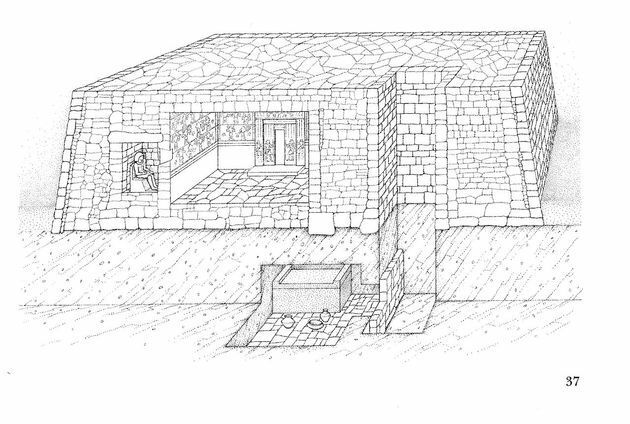
Characteristics of the pyramid of Djoser
Among its main features the following can be counted:
- 140 x 118 m rectangular base;
- Original height of 60 meters.
- Structure of six superimposed mastabas.
- Materials used: siliceous limestone and mortar for the body; fine limestone for the exterior coating.
- It underwent several redesigns over time, with the purpose of including the entire royal family and turning the building into a large complex.
- Contains:
- 11 wells 32 meters deep;
- 2 alabaster sarcophagi;
- rooms clad in faience slab;
- 48 thousand pieces of ceramics and stone vessels with inscriptions from previous dynasties.
- Djoser Burial Chamber:
- Located in the center of the pyramid.
- Materials: granite with plaster coating.
The pyramid of Snefru or bent pyramid

The first smooth-faced pyramid to be made in Egypt was that of the Pharaoh Snefru or Seneferu, who also ordered the construction of the so-called Red Pyramid, Pyramid of Meidum and Pyramid of Seila.
The Snefru pyramid is located 40 kilometers from the city of Cairo. It is distinguished by having an abrupt change of inclination in the upper half of its body. It is for this reason that it is also called a "bent pyramid".
It began to be built with an inclination of about 54º, which would have given it a greater height. Over time, the structure did not support the weight. The Egyptians had to correct the inclination to be able to carry out the work since it threatened to collapse from the weight. Therefore, from the second half, they opted for a 43º incline.
Characteristics of the pyramid of Snefru
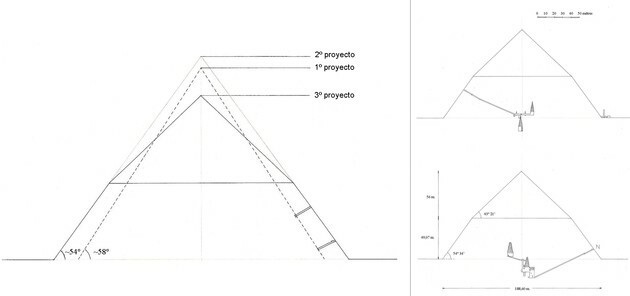
- Earring:
- Lower half: 54.34º;
- Upper half: 43º;
- Measurements: 188.60 meters wide by 105.07 meters high;
- Two entrances: a northern one and a western one. The latter makes it different from the rest of the pyramids;
- 1 false vault inside;
- Use for the first time of stepped vaults on four faces;
- 2 processional roads;
- Without sarcophagus;
- Closing system with harrows;
- Maintains the largest mars of the coating.
The red pyramid
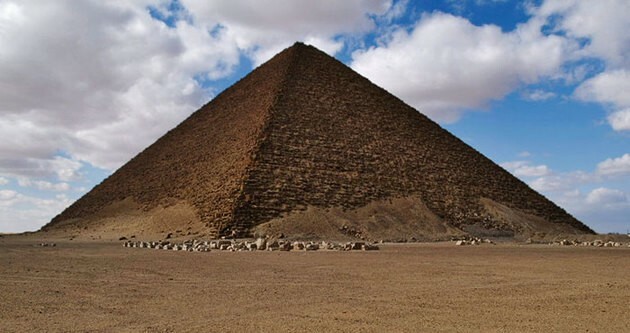
The red pyramid was also commissioned by Snefru or Seneferu. It is the first successful smooth-sided pyramid model. It was meant to be the tomb of this pharaoh. It gets its name from its current appearance, as it has lost all the white limestone exterior coating. In fact, it was formerly called "The Shining Pyramid". It is part of a funerary complex with a temple made of adobe.
Characteristics
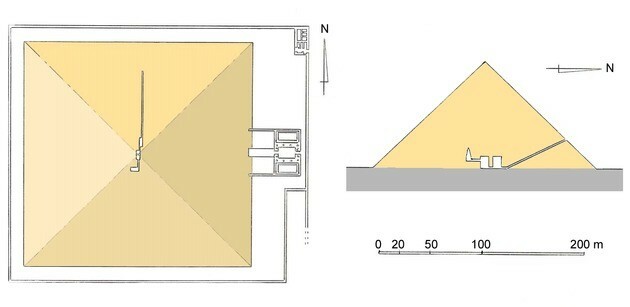
- Measurements: 104.40 meters high. Face from west to east of 221.50 meters; face from north to south of 218.50 meters.
- Slope: 43º.
- Materials: red limestone interior and white limestone cladding.
- Unique pyramid with faces at ground level.
- Two antechambers.
- Pyramidion smooth adjacent to the pyramid.
The pyramid of Cheops
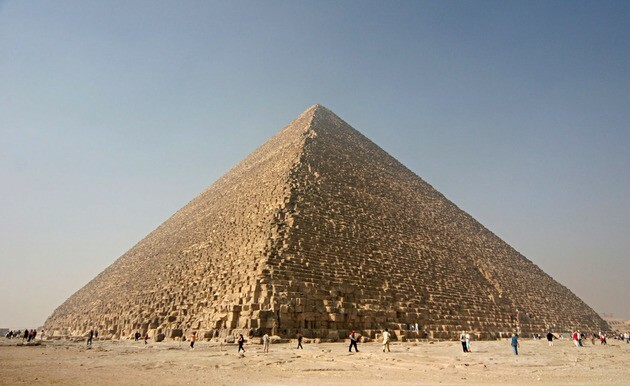
The pyramid of Cheops is known as the Great Pyramid of Giza It is located in the Necropolis of Giza. It was built in the 4th dynasty by the architect Hemiunu under the orders of Pharaoh Khufu. It is estimated that it could have been completed around the year 2570 BC. C.
Characteristics of the pyramid of Cheops

FOUNTAIN: Wikicommons.
- Measurements: 138 meters high by 227 meters wide.
- Slope: 51º 50 '39 ".
- Materials: body of common limestone and exterior cladding of polished white limestone.
- It lost part of its coating due to the earthquake of the 16th century, as well as the Ottoman looting.
- 3 main cameras:
- King's chamber: granite material, rectangular floor plan, smooth surfaces and the presence of a sarcophagus. Without decoration;
- Queen's Chamber: The name was wrongly attributed by the Arabs. The room contained an image or spiritual representation of the pharaoh, called Ka statue. Rectangular plan; gable roof; smooth walls without decoration;
- Underground chamber: rectangular plan; smooth walls and ceiling; uneven ground; 2 rooms and a well;
- 2 passageways, one ascending and one descending;
- 1 large gallery 47 meters long by 8 meters high, which forms a false vault;
- 2 ventilation channels for each real chamber.
The pyramid of Khafre

Also called the Jafra pyramid, this is also part of the funerary complex. In fact, on its eastern side it has a temple for this purpose as well as a processional road to the Temple of the Valley. It gives the impression of being the tallest due to its location.
Characteristics of the pyramid of Khafre
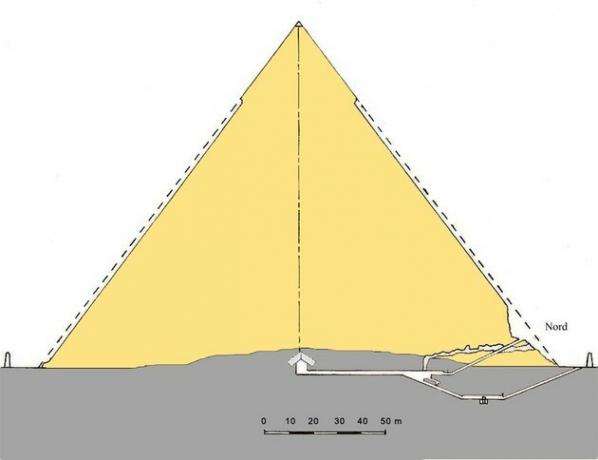
- Original measurements: 145.49 meters high by 215.25 meters. Currently its height is 143.48 meters.
- Slope: 53 ° 07 '48 ";
- Materials: common limestone body and polished white limestone exterior cladding;
- It was built following the Egyptian sacred triangle of proportions: 3-4-5;
- Contains:
- 2 entrances on the north side;
- 1 chamber carved in rock, with a gabled granite roof;
- 1 black granite sarcophagus.
The pyramid of Menkaure

The pyramid of Menkaura or Menkaure in Greek, is the smallest of the smooth-faced pyramids found in the Giza Necropolis. It was dedicated to Pharaoh Menkaura of the IV dynasty, son of Khafre and grandson of Cheops. Herodotus collected the testimonies about him, who was said to be a just ruler.
The enormous difference in scales between the pyramid of Menkaure and its predecessors is a sign of a breaking point. The construction of those two previous colossal pyramids had involved a great investment of material resources and a great human effort.
When Menkaure came to the throne, the weariness of that kingdom was evident. Although its pyramid would not be the last, it would be the last to be built solely in stone. Dynasties V and VI were content with small pyramids in which they used materials such as small stones and rubble for fillings.
It is believed that the rule of Menkaure had a sudden end, since the pyramid was finished in a crude way, when in fact it was intended to be clad in red granite. Instead, the stones that were used as a covering were painted to achieve the intended visual effect.
Today, the north face is cracked after the attempt by Al-Aziz Uthman, son of Saladin, to steal his treasures or use it as a quarry, which occurred in 1196. Something similar happened in the nineteenth century with the attempts of Colonel Howard Vyse and the engineer John Perring who, unlike the previous one, tried to make known the interior of the pyramids. The problem was that they used methods like gunpowder, which destroyed part of the heritage.
Little by little Vyse and Perring found other methods, and this allowed them to unravel the mystery of the interior of the pyramid. Among all that they found, they found a decorated red basalt sarcophagus, empty and without a lid. They packed it up to be sent to the British Museum, but the ship was wrecked on the way.
Characteristics of the pyramid of Menkaure
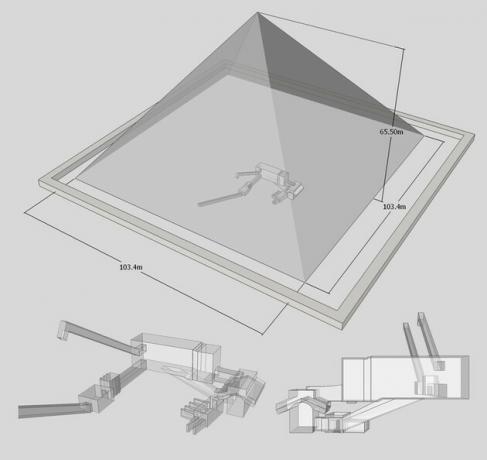
- Measurements: 64 meters high. 104.6 x 102.2 meter base.
- Slope: 51º 36 '21 ".
- Materials: common limestone body and red painted limestone exterior cladding;
- It is part of a complex on the south face of which there are 3 pyramids called "the pyramids of the queens" and a temple on the east face connected by a brick road;
- Descending passage of 31 meters in length;
- 1 chamber decorated with a false door;
- 1 antechamber;
- A second passage that leads to 6 niches.
How they built the pyramids of Egypt

Contrary to popular belief, the pyramids of Egypt were not built by slaves, but by free craftsmen. Egyptologists came to this conclusion after the discovery of several tombs with human remains, the burial elements of which made it possible to determine their occupation and even their diet. These workers were very well fed. The dedication to his craft was highly valued, since these tombs, in the vicinity of the pyramids, were decorated with care.
Little is known about how the pyramids were built, but experts rule out any non-human explanation. Today it has been learned that they used tools such as: copper saws not serrated with sand, whose friction made the cuts; squares with pendulums or plumb line to make measurements; copper chisels with arsenic; system of water channels to study the level of the base, etc.
The role of the pyramids of Egypt
Much has been speculated on the function of the pyramids of Egypt throughout history. Today it is known that these buildings served a funerary function. They were monumental mausoleums to house the body of the authorities after his death. But still, how would the channels found within these great masses of limestone and granite be explained? The answer is even more profound.
The ancient Egyptians believed that their pharaohs were true gods. Upon leaving the mortal plane, they must find their way to the afterlife. This would require two things in this world: first, to preserve the body from physical corruption, which is why they practiced mummification. Second, create conditions to guide them on their upward path.
So, that would be the ultimate function of the pyramids: authentic astro-spiritual devices or engines that would help the deceased to become an eternal star in the sky.
The symbology of the pyramids

Egyptologists believe with conviction that the pyramids were made by human hands, despite the challenge of explaining the construction of that marvel with such archaic methods. This does not deny that behind them there are symbols to decipher. After all, the human being is a symbolic animal.
For the most daring theorists, at least the pyramids of Cheops, Khafre and Menkaure would have a relationship with the cosmic dimension. This conclusion is based on the similarity between the alignment of these three pyramids and the alignment of the stars of Orion. This would only explain the pyramids of the Giza necropolis, so it does not offer a convincing answer about the pyramids as a whole.
Most Egyptologists agree to point out three essential symbolic elements of the pyramids: the first of them, the so-called benben stone or cornerstone; the second, Sun; the third, the Bennu bird.
The Benben stone o pyramidion It is a sacred stone in angular form (pyramidal, similar to the tip of a mountain), which was believed to have the power to illuminate whoever was under its influence. She was worshiped in the Temple of Ra in Hielópolis and in other latitudes of the empire. As a piece of worship, the stone used to be richly carved and golden in color so as to reflect light.

It gets its name from Egyptian mythology, according to which Benben was a primordial mountain that would have been born from the ocean of Nun. Benben would be the place of origin of the god Atum, and there he would create his consort. Thus, Benben is associated with the light of Sunnascent, image of the birth of the divine.
The symbology would not be complete without referring to the Bennu bird, the Egyptian equivalent of the Greek Phoenix, which is also related to the sun and has the property of being reborn from its ashes. According to Egyptian accounts, the Bennu bird used to stop at the top of the Benben.
These three elements make up a complete symbolic journey: the beam of the rising sun, which opens in pyramidal shape among the clouds touches the angled tip of Benben Mountain, where the eternal bird perches Bennu. Hence, therefore, the architectural model of the egyptian pyramids.
That is why Egyptian pyramids and also the obelisks were crowned with the cornerstone, which is also called pyramidion. Thus, one would have to imagine the luminous spectacle of those pyramids, covered in well-polished white limestone, under the inclement noonday sun. This dazzling spectacle would certainly be blinding. The pyramids would thus be erected as authentic sources of light, whose imposing power would subdue any mortal.
Video about Ancient Egypt
If you want to know in a brief and simple way the historical evolution of Ancient Egypt, do not miss this video with animation:
List of Egyptian pyramids
- Step Pyramid of Djoser. Dyeser (Zoser) -III dynasty. Saqqara.
- Buried pyramid. Sejemjet-III dynasty. Saqqara.
- Stratified pyramid. Jaba-III dynasty. Zawyet el-Aryan.
- Unfinished pyramid of Zawyet el-Aryan. Nebkara-IV dynasty. Zawyet el-Aryan.
- Pyramid of Meidum. Seneferu (1st) (started by Huny in 2612) -III / IV dynasties. Meidum.
- Layered pyramid. Seneferu (2nd) -IV dynasty. Dahshur.
- Red pyramid. Seneferu (3rd) -IV dynasty. Dahshur.
- Great Pyramid of Giza. Cheops (Jufu) -IV dynasty. Giza.
- The star Sehedu of Dyedefra (destroyed). Dyedefra-IV dynasty. Abu Roash.
- Pyramid of Khafre. Khafre (Jafra) -IV dynasty. Giza.
- Pyramid of Menkaure. Menkaura (Menkaura) -IV Dynasty. Giza.
- Mastaba of Shepseskaf. Shepseskaf-IV dynasty. Saqqara.
- Pyramid of Jentkaus I. Jentkaus I-IV dynasty. Saqqara.
- Pure are the places of Userkaf. Userkaf-V dynasty. Saqqara.
- Sahura's spirit shines. Sahura-V dynasty. Abuse
- Pyramid of the Ba of Neferirkara. Neferirkara-V dynasty. Abuse
- Unfinished pyramid. Shepseskara-V dynasty. Abuse
- Divine Pyramid of the Spirits of Ba. Neferefra-Isi (mastaba) -V dynasty. Abuse
- Nyuserre's places endure. Nyuserra-Iny-V dynasty. Abuse
- Nameless. Menkauhor-Ikauhor-V dynasty. Saqqara (?).
- Beautiful is Isesi. Dyedkara-Isesi-V dynasty. Saqqara.
- Perfect Unis locations. Unis-V dynasty. Saqqara.
- Pyramid of Teti The places of Teti endure. Teti-VI dynasty. Saqqara.
- Pepy's perfection is established. Pepy I-VI dynasty. Saqqara.
- Merenra's perfection appears. Merenra I-VI dynasty. Saqqara.
- Pepi is established and alive. Pepy II-VI dynasty. Saqqara.
- Nameless. Neferkara Neby-VII dynasty. Saqqara (?).
- Unnamed (mastaba) .Kakaura Ibi-VIII Dynasty. Saqqara.
- Pyramid of Jui. Jui-VIII dynasty. Give to.
- Nameless. Iti-VIII dynasty. (?)
- Nameless. Merykara-X dynasty. (?)
- The places of appearance of Amenemhat. Amenemhat I-XII dynasty. El-Lisht.
- Senusert contemplates the two lands. Senusert I-XII dynasty. El-Lisht.
- White pyramid. Amenemhat II-XII dynasty. Dashur.
- Senusert appears. Senusert II-XII dynasty. El-Lahun.
- Nameless. Senusert III-XII dynasty. Dahshur.
- Black Pyramid. Amenemhat III (1st) -XII dynasty. Dahshur.
- Amenemhat lives. Amenemhat III (2nd) -XII dynasty. Hawara.
- Nameless. Amenemhat IV-XII dynasty. Mazghuna.
- Nameless. Neferusobek-XII dynasty. Mazghuna.
- Nameless. Ameny Qemau-XIII dynasty. Dahshur.
- Jendyer's pyramid. Jendyer-XIII dynasty. Saqqara.
- Pyramid of Amosis. Amosis I-XVIII dynasty. Abydos.



